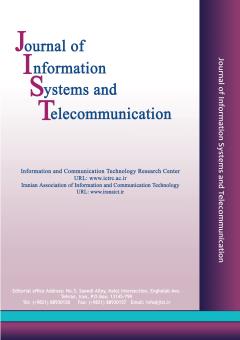Broadband Low-cost Reflectarray based on a New Phase Synthesis Technique and a Class of Cross Bow-Tie Cells
Subject Areas : Electromagnetic, Antenna and Propagation
Mahmood Rafaei-Booket
1
![]() ,
Mahdieh Bozorgi
2
,
Seyed Mostafa Musavi
3
,
Mahdieh Bozorgi
2
,
Seyed Mostafa Musavi
3
1 - Department of Electrical and Computer Engineering, University of Zanjan, Zanjan, Iran
2 - Department of Electrical and Computer Engineering, University of Zanjan, Zanjan, Iran
3 - Missouri University of Science and Technology, USA
Keywords: Reflectarray, Cross Bow-Tie unit cell, Broadband Antenna, Phase Synthesis Method, Low-cost structure,
Abstract :
In this paper, a class of Bow-tie unit cell on FR4 substrate is designed and investigated to be used in implementing a single-layer broadband Reflectarray Antenna (RA). In the analyzing step, two different parameters (length and angle) of the grounded Cross Bow-Tie (CBT) are varied to obtain the phase diagrams. Various degrees of freedom in the CBT structure are very helpful in designing a broadband RA. In the antenna design procedure, an efficient phase synthesis technique is applied to minimize the adverse effects of frequency dispersion causing by the differential space phase delay at different frequencies. This technique optimizes the metallic CBTs arrangement on the aperture of RA, and reduces the dependency of RA design to the CBT’s phase variation. Consequently, combination of the CBT’s phase behavior and the phase synthesis technique leads to designing a broadband RA with a good frequency response. In addition to, the Side Lobe Level (SLL) of the resultant RA is reduced remarkably. For validation of the obtained numerical results, an RA is designed and fabricated in 8.7~12.3GHz frequency bandwidth. The measurements show 27.03 dB as a maximum gain value at 10.2 GHz with a 1.5dB gain bandwidth of 34%. It is also shown that the implemented RA exhibits a reduced SLL (<-18dBi) within its operating bandwidth.
[1] J. Huang, and J. A. Encinar, Reflectarray Antennas, Hoboken. NJ: John Wiley & Sons, 2008.
[2] D. M. Pozar, “Bandwidth of reflectarrays,”, Electron Lett., Vol. 39, No. 21, 2003, pp. 1490-1490.
[3] M. Rafaei-Booket, and Z. Atlasbaf, “New Ku-band reflectarray antenna by using anisotropic superstrate on an artificial magnetic conductor,” International Journal of Microwave and Wireless Technologies, Vol. 9, 2016, pp. 831-841.
[4] M. Rafaei-Booket, Z. Atlasbaf, and M. Shahabadi, “Broadband reflectarray antenna on a periodically perforated substrate,” IEEE Trans. Antennas Propag., Vol. 64, No. 8, 2016, pp. 3711-3717.
[5] J. A. Encinar, and J. A. Zornoza, “Three-layer printed Reflectarrays for contoured beam space applications,” IEEE Trans. Antennas Propag., Vol. 52, No. 5, 2004, pp. 1138-1148.
[6] M. Rafaei-Booket, and Z. Atlasbaf, “Metallic grating embedded in an anisotropic slab for realization of a reflectarray antenna,” In 23th Iranian Conference on Electrical Engineering (ICEE), 2015, pp. 10-14.
[7] M. Bozorgi, and M. Rafaei-Booket, “Metallic array on a biased Ferrite substrate as a reflectarray antenna,” In 9th International Symposium on Telecommunications (IST), 2018, pp. 80-85.
[8] M. Rafaei-Booket, and S. M. Mousavi, “Efficient analysis method and design approach for broadband reflectarrays with isotropic/-artificial anisotropic substrates,” IET Microwaves, Antennas & Propag., Vol. 14, No. 10, 2020, pp. 1108-1116.
[9] X. Li, Y. Wan, J. Liu, D. Jiang, T. Bai, K. Zhu, J. Zhuang, and W.-Q. Wang, “Broadband electronically scanned reflectarray antenna with liquid crystals,” IEEE Antennas and Wireless Lett., Vol. 20, No. 3, 2021, pp. 396-400.
[10] E. Carrasco, M. Barba, and J. A. Encinar, “Reflectarray element based on aperture-coupled patches with slots and lines of variable length,” IEEE Trans. Antennas Propag., Vol. 52, No. 3, 2007, pp. 820-825.
[11] E. Carrasco, J. A. Encinar, and M. Barba, “Bandwidth improvement in large Reflectarrays by using true-time delay,” IEEE Trans. Antennas Propag., Vol. 56, No. 8, 2008, pp. 2496-2503.
[12] E. Ozturk, and B. Saka, “Multilayer Minkowski reflectarray antenna with improved phase performance,” IEEE Trans. Antennas Propag., 2021, DOI: 10.1109/TAP.2021.3090533.
[13] M. R. Chaharmir, J. Shaker, N. Gagnon, and D. Lee, “Design of broadband, single layer dual band large reflectarray using multi open loop elements,” IEEE Trans. Antennas Propag., Vol. 58, No. 9, 2010, pp. 2875-2883.
[14] H. Rajagopalan, and Y. Rahmat-Samii, “On the reflection characteristics of a reflectarray element with low-loss and high-loss substrates,” IEEE Trans. Antennas Propag., Vol. 52, No. 4, 2010, pp. 73-85.
[15] F. Costa, and A. Monorchio, “Closed-form analysis of reflection losses in microstrip reflectarray antennas,” IEEE Trans. Antennas Propag., Vol. 60, No. 10, 2012, pp. 4650-4660.
[16] J. Ethier, M. R. Chaharmir, and J. Shaker, “Loss reduction in reflectarray designs using sub-wavelength coupled-resonant elements,” IEEE Trans. Antennas Propag., Vol. 60, No. 11, 2012, pp. 5456-5459.
[17] P. Nayeri, F. Yang, and A. Z. Elsherbani, “Braodband reflectarray antennas using double-layer subwavelength patch elements,” IEEE Antennas Propag. Lett., Vol. 9, 2010, pp. 1139-1142.
[18] M. Bozorgi, and Z. Atlasbaf, “Spectral solution for scattering analysis of periodic plasmonic nano-antennas on iso/-anisotropic substrate,” J. Lightwave Technol., Vol. 34, No. 11, 2016, pp. 2624-2630.
[19] Y. Mao, Sh. Xu, F. Yang, and A. Z. Elsherbani, “A novel phase synthesis approach for wideband reflectarray design,” IEEE Trans. Antennas Propag., Vol. 63, No. 9, 2015, pp. 4189-4193.
[20] H. Hasani, M. Kamyab, and A. Mirkamali, “Low cross-polarization reflectarray antenna,” IEEE Trans. Antennas Propag., Vol. 59, No. 5, 2011, pp. 1752-1756.
[21] M. Maddahali, and K. Forooraghi, “High efficiency reflectarray using smooth tapering in phase pattern on antenna surface,” Microwave and Optical Lett.,Vol. 55, No. 4, 2013, pp. 747-753.
[22] R. S. Malfajani, and B. A. Arand, “Dual-band orthogonally polarized single layer reflectarray antenna,” IEEE Trans. Antennas Propag., Vol. 65, No. 11, 2017, pp. 6145-6150.
[23] J. Huang, “Analysis of a microstrip reflectarray antenna for micro- spacecraft application,” TDA Progress Report, 1995.
[24] C. A. Balanis, Antenna Theory: Analysis and Design, 3rd ed. John Wiley & Sons; 2005.
[25] M. Rafaei-Booket, and M. Bozorgi, “Low-cost inhomogeneous material for low-RCS reflectarray antenna implementation,” AEU- International Journal of Electronics and Communications, Vol. 149, 2022, pp. 154182.


